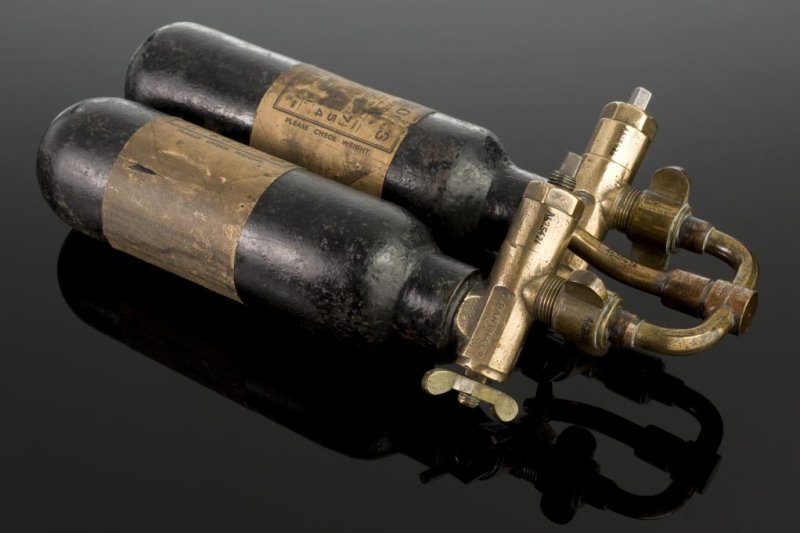Nitrous oxide or laughing gas was used as an anesthetic for dentistry starting in the 1840s. Each of the cylinders above contains 25 gallons of liquid nitrous oxide. The average patient required about six gallons in the 1850s, when the gas started to be mass produced as a liquid, with dentists preferring to have two cylinders on hand in case one stopped working or ran out during an operation. Photo by Science Museum London/Wellcome Images
LONDON, March 4 (UPI) -- Nitrous oxide treatment may help prevent the long-term formation of distressing memories after a traumatic experience, researchers found in a recent study.
Researchers at University College London found intrusions by distressing memories decreased more quickly in people treated with the commonly used gas, which they say suggests it could be used for certain patients after traumatic events and possibly for post-traumatic stress disorder.
Nitrous oxide has been used as an anesthetic since the 1840s and is used regularly as a painkiller for everything from emergency treatments to dental procedures.
The gas has also been popular as a recreational drug, with users often inhaling it through a balloon or other device.
The researchers looked to nitrous oxide for the study because it is known to block N-Methyl D-Aspartate, or NMDA, receptors in the brain that tag information during waking hours for long-term storage as a memory during sleep. The theory, they say, is that nitrous oxide could be used to prevent the permanent formation of traumatic memories.
"Nitrous oxide is routinely used as a painkiller by paramedics and in [emergency] departments because it is safe and easy to administer," Dr. Sunjeev Kamboj, a professor at University College London, in a press release. "Many people who end up in an ambulance will have undergone some form of psychological trauma, and our study suggests that the nitrous oxide is likely to be having some effect on how their brain processes it."
For the study, published in the journal Psychological Medicine, researchers recruited 50 healthy people, showing them two clips from the controversial French film "Irréversible," one in which a man's face is beaten with a fire extinguisher and the other a graphic, 10-minute long rape scene.
After watching the clips, participants were then asked to breathe either nitrous oxide or medical oxygen for 30 minutes and to keep a diary for a week assessing the frequency of intrusive thoughts related to the clips. At the end of the week, the participants then completed an explicit memory task related to the clip they'd seen.
The day after seeing the clips, the people who received nitrous oxide experienced a drop in intrusive thoughts by more than half, researchers reported. The decline in intrusions was slower, however, for those given air, and a large drop was not seen until four days after viewing the film clips.
People who felt more dissociated also had more intrusive memories as a result of seeing the clips. Dissociation is a measure of feeling detached from a situation or themselves and often involves a feeling that things are "dream-like," and can be a sign of PTSD.
Further research is needed to find if nitrous oxide could help with PTSD, because the gas induces a dissociated feeling and could make PTSD worse, though Kamboj said its efficacy would depend on individual patients' conditions.
Kamboj noted that study participants breathed the gas for 30 minutes and felt the memory-related effects, whereas the amount of nitrous oxide in a balloon used for recreational purposes would be unlikely to have a "noticeable" effect.
The longer-term effects of nitrous oxide and when it should be given to patients must be determined, the researchers said, as well as whether the formation of memories from real trauma can be affected with nitrous oxide.
"Our next step is to look at whether we can get the same effects by destabilising people's preexisting memory of the unpleasant film and then giving them nitrous oxide," Dr. Ravi Das, a researchers at University College London, told Vice. "And if we can, then that means there's essentially no time limit on when it could be useful, so that's really exciting for us."















